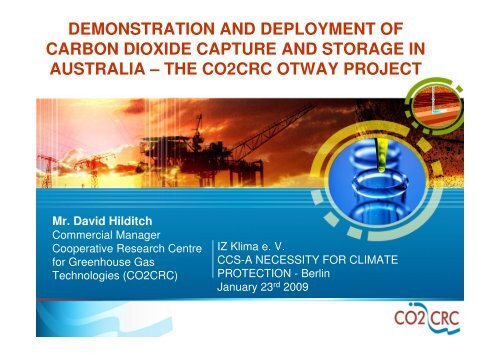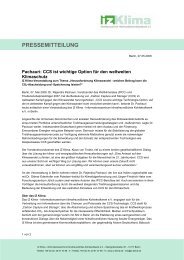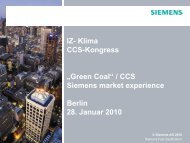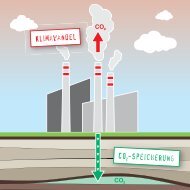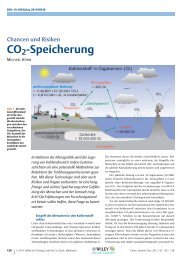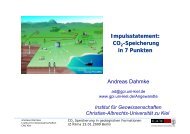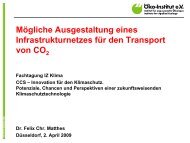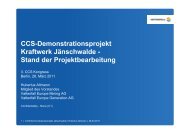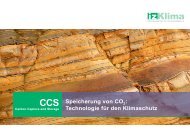CO2CRC Otway Project - IZ Klima
CO2CRC Otway Project - IZ Klima
CO2CRC Otway Project - IZ Klima
You also want an ePaper? Increase the reach of your titles
YUMPU automatically turns print PDFs into web optimized ePapers that Google loves.
DEMONSTRATION AND DEPLOYMENT OF<br />
CARBON DIOXIDE CAPTURE AND STORAGE IN<br />
AUSTRALIA – THE <strong>CO2CRC</strong> OTWAY PROJECT<br />
Mr. David Hilditch<br />
Commercial Manager<br />
Cooperative Research Centre<br />
for Greenhouse Gas<br />
Technologies (<strong>CO2CRC</strong>)<br />
<strong>IZ</strong> <strong>Klima</strong> e. V.<br />
CCS-A NECESSITY FOR CLIMATE<br />
PROTECTION - Berlin<br />
January 23 rd 2009
<strong>CO2CRC</strong> collaborative research involves 33 partner organisations, more<br />
than 100 researchers and a budget of more than A$20M per annum
<strong>CO2CRC</strong> Participants<br />
Supporting participants: Department of Resources, Energy and Tourism-AusIndustry |The Department of Environment, Water,<br />
Heritage and the Arts | CANSYD | Meiji University | The Process Group | University of Queensland | Newcastle University<br />
Established & supported under the Australian Government’s Cooperative Research Centres Programme
2001 - CO 2 source-sink studies - GEODISC TM
Regions being studied for potential CCS pilot projects
2008 - Carbon capture and storage projects in Australia
<strong>CO2CRC</strong> <strong>Otway</strong> <strong>Project</strong><br />
Buttress<br />
Naylor-1
<strong>Project</strong> Area- <strong>CO2CRC</strong><br />
purchased two petroleum<br />
tenements
<strong>CO2CRC</strong> <strong>Otway</strong> <strong>Project</strong> facilities<br />
Buttress Site: CO2 production<br />
well (Buttress-1) & Surface<br />
Plant<br />
Naylor-1 Site: Monitoring<br />
well (Naylor-1)<br />
Pipeline<br />
Air Monitoring Site: Lo-Flo & Flux Tower<br />
CRC-1 Site: Injection well (CRC-1)<br />
<strong>CO2CRC</strong> Visitor’s Centre
<strong>CO2CRC</strong> <strong>Otway</strong> <strong>Project</strong><br />
Nirranda, Warrnambool, Victoria
<strong>Otway</strong> Basin, Victoria
<strong>CO2CRC</strong> <strong>Otway</strong> <strong>Project</strong> Concept
<strong>CO2CRC</strong> <strong>Otway</strong> <strong>Project</strong> Process Map<br />
Phase 1<br />
Opportunity<br />
Definition<br />
Phase 2<br />
Select<br />
Alternatives<br />
Phase 3<br />
Define<br />
(FEED)<br />
Phase 4<br />
Execution<br />
Phase 5<br />
Operations &<br />
Evaluation<br />
Feasibility<br />
<strong>Project</strong><br />
Development<br />
Reduction of<br />
Uncertainty<br />
Capital<br />
Expenses<br />
Injection and<br />
Demonstration<br />
6/04 1/05 12/05 8/06 6/10<br />
4/08
Stage 1 involves injection<br />
of 50-100K tonnes CO2 into<br />
the Waarre Formation, a<br />
depleted gas field.<br />
Stage 2 will involve<br />
injection into the Paaratte<br />
Formation, a saline aquifer
Seismic profile across the site of the <strong>CO2CRC</strong> <strong>Otway</strong> <strong>Project</strong>
Development of static and dynamic models of the<br />
reservoir was a key part of the project<br />
• Building detailed reservoir models for the appropriate depositional environment<br />
(low sinuosity braided fluvial system)<br />
• History matching with actual production data to validate model<br />
Rigorous multi-disciplinary studies based on established oil field processes<br />
validated through peer reviews, were a key component of taking the project<br />
forward. This involved:-<br />
Preproduction<br />
Oct. 2003,<br />
water hits the<br />
Naylor 1 well<br />
Pre-injection
Sealing faults are an important feature of the project area<br />
© <strong>CO2CRC</strong>.<br />
All rights reserved.
CRC-1 injection well<br />
An injection well (CRC-1) was drilled to 2200m<br />
Injection well
Coring in a new well, CRC-1, confirmed an excellent reservoir and seal<br />
Core sample, CRC-1
Source of carbon dioxide: Buttress-1 well and compressor<br />
Compressor<br />
Process skid<br />
After cooler<br />
Production well
An existing<br />
abandoned well<br />
(Naylor-1) was<br />
equipped as a<br />
monitoring well,<br />
with Lawrence<br />
Berkeley National<br />
Laboratories<br />
playing a crucial<br />
role
Transporting the CO2 by pipeline
Monitoring and Verification is a key part of CCS<br />
Atmospheric<br />
Atmosphere<br />
Assurance<br />
Monitoring<br />
Soil gas<br />
Surface<br />
Ecosystems<br />
Hydrology<br />
Geochemistry<br />
Saline Water<br />
Storage Integrity<br />
Monitoring<br />
Seismic (Remote Geophysics)<br />
Geochemical Sampling<br />
Injected<br />
Carbon Dioxide<br />
Seal<br />
Confining Layer(s)
Downhole fluid sampling was undertaken to<br />
better understand subsurface processes<br />
Schematic of bottom hole completion<br />
Top<br />
WarreC<br />
Geologic Column<br />
2000 m<br />
Packer<br />
2030 m<br />
2035 m<br />
Casing 2.9” I.D.<br />
Custom completion tubing<br />
Patch 2.375” ID; 27’ long<br />
2028-2035 m<br />
Perf<br />
2040 m<br />
Expected Gas/Water<br />
80 o C<br />
17 MPa (2500psi)<br />
2045 m<br />
Pressure/Temp and<br />
U-tube Inlet<br />
2050 m<br />
Geophone with clamp<br />
2055 m<br />
Total Depth: 2060 m<br />
Hydrophone<br />
Oct 9, 2007
Downhole seismic assembly (Subsurface)<br />
GEOPHYSICS<br />
STORAGE INTEGRITY<br />
MONITORING<br />
Vertical Seismic Profiling (VSPs):<br />
Objective: provides a high resolution image of the<br />
immediate vicinity of the boreholes<br />
Methods: Offset VSP, Walkaway VSP<br />
Set-up: CRC-1-wireline, Naylor-1: permanently installed<br />
High Resolution Travel Time (HRTT)<br />
Concept: the injected CO2 is expected to rise and<br />
collect beneath the gas cap and continuous injection<br />
will force the gas-water contact (GWC) down.<br />
Objectives: test the ability to monitor fine changes in<br />
fluid level and verify the volume injected<br />
Set up: permanently installed geophones strategically<br />
located above and below the GWC in the observation<br />
Naylor-1 well<br />
Microseismic<br />
Objective: to assure that the in-situ conditions of the<br />
reservoir have not lead to fractures or fault reactivation<br />
Methods:<br />
Subsurface & Surface microseismic systems
3D surface seismic monitoring (Subsurface)<br />
GEOPHYSICS<br />
ASSURANCE MONITORING/<br />
STORAGE INTEGRITY MONITORING<br />
Methods: 4D or time-lapse surveys<br />
Repeatability of surveys before,<br />
during and after the CO2 injection<br />
is very important for every aspect of<br />
acquisition (source and receivers<br />
positioning; source signal;<br />
hardware; time of year; processing)
Hydrodynamics & groundwater Monitoring (Near-Surface)<br />
GEOCHEMISTRY<br />
ASSURANCE MONITORING<br />
Objective:<br />
- Monitor water levels to determine seasonal<br />
variation, flow rate and direction<br />
- Identify any chemical changes associated with<br />
possible CO2 leakage<br />
5-10m<br />
Cap<br />
Cable permanently installed<br />
Steel Cable<br />
Waterlevel<br />
Datalogger<br />
Methods:<br />
- Dataloggers<br />
- Water chemistry<br />
Screen<br />
Aquifers monitored:<br />
- Shallow unconfined Port Campbell Limestone,<br />
- Deep confined Dilwyn aquifer
Soil Gas Monitoring (Surface)<br />
GEOCHEMISTRY<br />
ASSURANCE SURFACE MONITORING<br />
Objective:<br />
- Establish CO2 variations within the extended<br />
area beyond the <strong>CO2CRC</strong> tenements<br />
- Determine the likely source of origin<br />
- Differentiate natural from injected CO2.<br />
Methods:<br />
- The soil gas program extracts air from the<br />
unsaturated soil zone above the water table.<br />
- Samples are analysed on site (portable gas<br />
chromatograph) and in the laboratory for CO2,<br />
CH4 and isotopes.
Atmospheric Monitoring<br />
Objectives:<br />
To verify that injected CO2 stays underground; or in the unlikely event<br />
of leakage to surface, demonstrate the capacity to detect and quantify<br />
surface leakage<br />
<strong>Otway</strong><br />
Cap Grim<br />
baseline wind sector
<strong>CO2CRC</strong> <strong>Otway</strong> <strong>Project</strong> Non-Technical Challenges<br />
• Regulatory<br />
– No existing regulation for geosequestration.<br />
• Organisational<br />
– <strong>CO2CRC</strong> not an operating entity with a defined life span<br />
– Not all <strong>CO2CRC</strong> participants able to shoulder operational liability<br />
• Liability Management<br />
– Research <strong>Project</strong>: Operational Liability not offset by project NPV.<br />
– Need for a solution to long term liability.<br />
• Community<br />
– First of its kind with no national precedent<br />
– Mixed reports in media
Complexity of Legislation<br />
Petroleum<br />
Act<br />
DPI<br />
EPA<br />
SRW<br />
Well Ops<br />
Planning<br />
Act –<br />
DSE/Shire<br />
M&V
<strong>CO2CRC</strong> <strong>Otway</strong> <strong>Project</strong> International Context<br />
Geological Data<br />
Availability<br />
Baseline<br />
data<br />
Reservoir<br />
Geochem<br />
Ground water<br />
monitoring<br />
Regional Reservoir Hydrology Geochem<br />
Soil<br />
Gas<br />
Atmos<br />
Geophysics<br />
Containment<br />
Risk Ass.<br />
prior to<br />
project<br />
start<br />
West<br />
Texas<br />
Largely<br />
confidential<br />
very limited<br />
limited<br />
Alberta<br />
Basin<br />
limited<br />
very limited<br />
Sleipner limited limited<br />
Weyburn<br />
Largely<br />
confidential<br />
limited<br />
Frio limited limited limited<br />
Japanese<br />
<strong>CO2CRC</strong><br />
<strong>Otway</strong>
<strong>CO2CRC</strong> <strong>Otway</strong> <strong>Project</strong> - Stage 2<br />
Opportunity to better understand residual trapping of CO 2<br />
in saline aquifers<br />
Purpose:<br />
Expand the scope of the<br />
work by building on<br />
knowledge and facilities<br />
established for Stage 1<br />
Description:<br />
Injection of CO 2 into the<br />
Paaratte Formation<br />
Science Objectives:<br />
- Characterise, model and<br />
simulate CO 2 migration in<br />
a heterogeneous reservoir<br />
in a saline environment<br />
- Deploy cost effective,<br />
reliable enhanced M&V
<strong>CO2CRC</strong> <strong>Otway</strong> <strong>Project</strong> Summary<br />
• Australia’s first storage project<br />
• Injection commenced April<br />
2008; 50-100K tonnes carbon<br />
dioxide to be injected; 20K to<br />
date<br />
• <strong>Project</strong> will run to at least mid<br />
2010<br />
• Stage 1 cost A$40M- started<br />
• Stage 2 cost A$20M- proposed<br />
• Monitoring and verification a<br />
key component<br />
• Learnings include regulation,<br />
risk, liability, technology,<br />
science, ops,corp structure,<br />
communications, community<br />
• Enhanced profile for CCS
Thank you!<br />
My thanks to <strong>CO2CRC</strong> sponsoring and collaborating organisations.<br />
I acknowledge the outstanding contribution of Sandeep Sharma<br />
( <strong>Project</strong> Manager) and the many <strong>CO2CRC</strong><br />
colleagues from a range of Australian and international organisations.<br />
Funding provided by the <strong>CO2CRC</strong> Members, the Federal Dept of Resources and<br />
Energy, Victorian Dept Primary Industries, US Dept of Energy<br />
.


